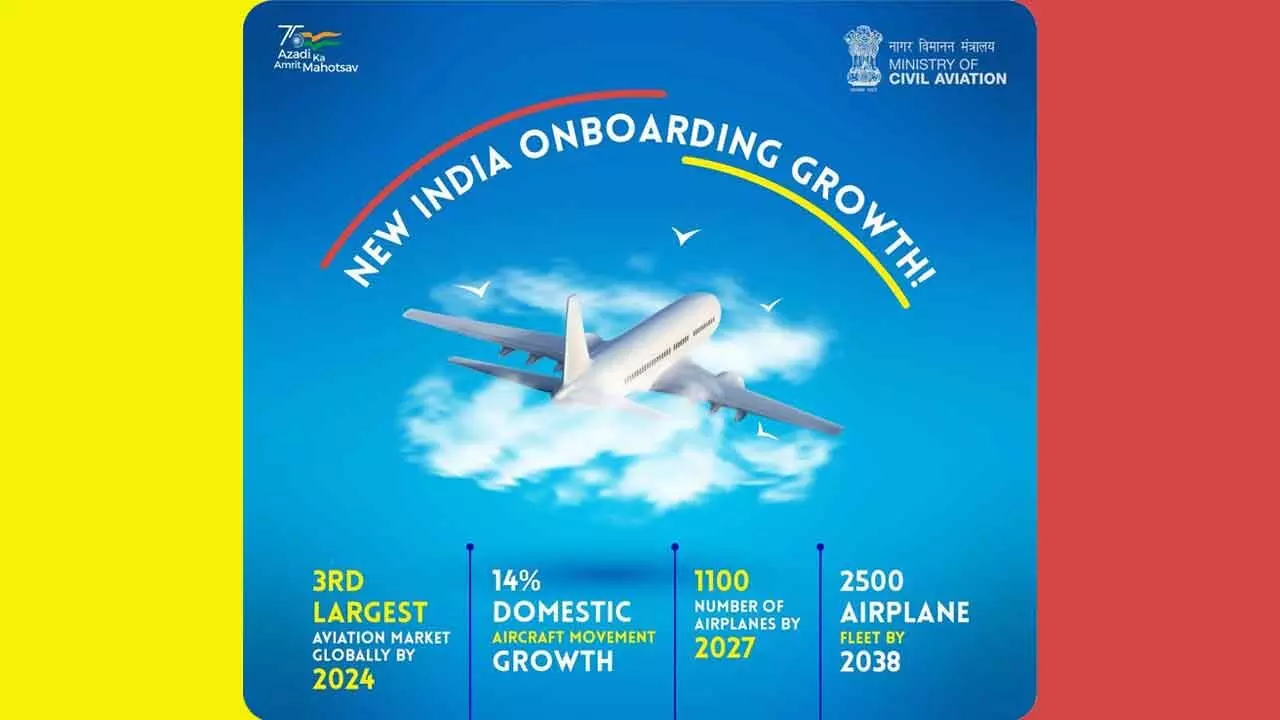Can Indian aviation industry grow in proportion to rising passenger numbers?
Tata’s first ‘MadeinIndia’ aircraft will roll out of its Baroda facility in September 2026
image for illustrative purpose

IATA predicts that it will be the third-largest fleet in the world by 2026 surpassing the UK. A 2023 CRISIL report states that India’s MRO sector still faces obstacles such as difficulty obtaining credit, inadequate infrastructure, high taxes, licensing and certification issues, and high rental costs. But the Indian government has introduced several policies to support making the country a global MRO hub
Domestic air traffic in India increased by nine per cent year-on-year last month to reach 12.7 million passengers, according to data released by the Directorate General of Civil Aviation (DGCA).
Mumbai's international airport reported its highest monthly passenger traffic at 4.46 million.
Although it is a challenge faced by airlines worldwide, Capa says India is especially vulnerable because it has a high proportion of narrow body planes in its fleet and these aircraft are often subject to engine issues.
As per DGCA, the passenger count of domestic airlines reached 1,254.98 lakh between January and October, as against 988.31 lakh during the corresponding period of the previous year thereby registering an annual growth of 26.98%.
The increase in the volume of passengers reflects on India’s rising economy, income levels and demonstrates the strength and durability of the country’s aviation sector and the rising demand for air transportation.
There is a healthy recovery in passenger traffic but an uncertain global situation impacting aviation turbine fuel and the exchange rate, along with engine groundings, indicates that 2024 will be an operationally challenging year for the aviation sector.
More investment in maintenance, repair and overhaul facilities, both within India and globally, could be an effective longer-term solution to easing such problems, analysts say.
A Bain and Company report forecasts that by 2030, Europe-North America travel could increase about 17% from its 2019 demand volume in the baseline scenario, while Asia intra-regional travel could jump 61%.
Asia maintains a much stronger outlook for long-term disposable income growth, and low-cost carriers also continue to accelerate growth.
The Tata group companies are already building aero-structures for many helicopters and also C-130J transport aircraft for global customers. Tata Group is working with GE to manufacture CFM International LEAP engine components in India. Many Indian MSMEs and start-ups are in aircraft systems production.
Meanwhile a Tata consortium will be building 40 EADS CASA C-295 MW aircraft and significant numbers of its sub-systems in India at a plant in Baroda.
The first Made-in-India aircraft will roll out of the new facility in September 2026. Before the completion of deliveries in 2031, a D-level MRO (maintenance, repair, and operations) facility will be set up in India. This facility will act as a regional MRO hub for various variants of C-295 aircraft.
The indigenous content in these planes will be the highest ever in India, with 96 per cent of the work that Airbus does in Spain gradually being done at the new facility here. More than 125 domestic MSME suppliers spread across different states. This project should also help India in pushing its commuter aircraft.
While Boeing and Airbus have dominated the large commercial aircraft market, there are other players in regional jets which are smaller aircraft, fly shorter ranges, and carry fewer passengers. Bombardier of Canada and Embraer of Brazil are the historical leaders in the regional jet market. Commercial markets also include turboprops. There are other players in the business jet market such as Beechcraft, Cessna, Dassault, and Gulfstream, etc.
India is the fastest-growing airline market, and there is a huge demand for civil aircraft and their aero-engines. Thehuge Maintenance Repair and Overhaul (MRO) market needs to be tapped. The next logical step would be to build our own short haul ATR-42 and 72 class aircraft, and later also single-aisle aircraft of Boeing 737 and Airbus A320 class.
India has a huge MRO market for civil and military aircraft and engines. The current airliner fleet of around 750 aircraft can more than double in five years. IATA predicts that it will be the third-largest fleet in the world by 2026 surpassing the UK. A 2023 CRISIL report states that India’s MRO sector still faces obstacles such as difficulty obtaining credit, inadequate infrastructure, high taxes, licensing and certification issues, and high rental costs. But the Indian government has introduced several policies to support making the country a global MRO hub. These include reducing GST on MRO services from 18% to 5%, land lease policies for longer durations to lower rental costs, and discontinuing the 13% government charged royalty on revenue. These should support reduction of costs by 10-20 percent.
As per NitiAyog report of October 2022, the Indian MRO industry was $1.7 billion in 2021. The global MRO market was worth $78.6 billion in 2022. The Indian market is expected to be $4.0 billion by 2031, growing at 8.9% CAGR, faster than any other country. India thus has great potential to be a significant regional MRO hub and gradually strives to establish its foothold in the global supply chain.

